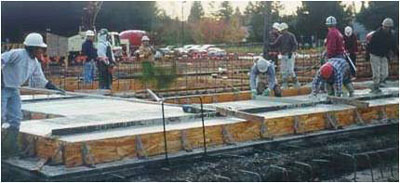Tilt up walls construct quicker and require fewer skilled workers than masonry walls.
R value of tilt up concrete wall.
In fact concrete allows energy to flow through it roughly 60x faster than insulation.
As building codes require greater energy efficiency the thickness of insulation increases.
Walls can range from r values of about 2 for uninsulated panels up to about 32 for walls containing thicker layers of insulation.
The r value of an uninsulated 8 inch thick basement wall built using normal weight concrete is 1 35 based on data from the 1993 american society of heating refrigeration and air conditioning engineers handbook.
By doubling the thickness of the wall to 16 inches the r value only increases by 0 50.
The steady state thermal analysis shows the total isothermal r value for the wall with the ability to factor in thermal breaks such as metal ties or solid concrete sections.
For instance if you have a material with an r value of 12 attached to another material with an r value of 3 then both materials combined have an r value of 15.
You will notice in the findings shown in the isothermal analysis that the thermomass wall panel has a material r value of r 11 49.
As we said before the r value measures the thermal resistance of a material.
What s the r value of a tilt up concrete wall the simple answer to the question is solid tilt up concrete panels have very little r value 0 08per inch.
R value drywall steel framing 1 quik therm concrete wall 9 8 drywall steel framing 2 quik therm concrete wall 14 3.
But like all concrete systems tilt up offers high thermal mass and airtight construction.
However insulation can be added easily to any tilt up panel.

